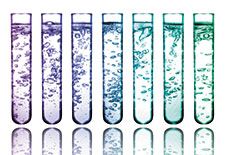Hazardous Chemistry: Choosing Batch or Flow
For many processes involving hazardous chemistry, running in flow mode has safety and economic advantages.
Maram/shutterstock.com

Flow chemistry is no longer a novel technology largely relegated to drug discovery laboratories. Most pharmaceutical companies and some contract manufacturers have embraced continuous manufacturing to some degree for both drug substance and drug product manufacturing. Several factors are considered when determining whether batch or flow production methods are warranted.
Considering the hazards
The switch from batch to flow chemistry is often driven by the need to perform hazardous reactions, according to Matthew M. Bio, president and CEO of Snapdragon Chemistry. “Flow chemistry is an excellent way to deal with gas/liquid reactions and reactions that are run under high pressures, at high temperatures, or that involve unstable intermediates that require low temperatures,” he says.
At Hovione, the hazard source is first identified. In addition to the above examples, highly exothermic reactions and reactions with highly toxic/corrosive reactants are also good candidates according to Rui Loureiro, director R&D process chemistry development with the company. “Reactions that involve hazards that cannot be easily controlled under batch conditions are typically performed using flow chemistry,” he says.
Loureiro does note, however, that not all hazardous reactions are automatically switched to flow chemistry. “Many catalytic hydrogenations and hydrolysis reactions have been performed in batch for a long time in a safe manner. In such cases where safety is not compromised, the decision to move to flow should consider the required throughput versus the investment in time and costs,” he observes.
Reactions that involve suspensions are also often a challenge in flow chemistry, particularly during the development stages using smaller equipment, according to Filipe Ataíde, team leader of Hovione’s continuous manufacturing group. “Such processes often must be studied at much lower concentrations, which can make it difficult to define the benefits of flow versus what can be achieved in the batch process,” he comments.
The reaction time/rate is usually the primary indicator as to whether the reaction is practical in flow, according to Bio. Long reaction times would result in tubular or continuous stirred-tank reactors that are quite large. For these slow reactions, however, flow chemistry still presents opportunities. “With the expanded processing windows available in flow (e.g., pressure, temperature), many reactions that at first glance would appear as poor candidates for flow can be successfully developed as continuous processes,” he asserts.
Knowing the process kinetics also helps convert batch processes to flow, since the equipment can be designed to fit the kinetics, agrees Rudi Oliveira, an R&D chemist in Hovione’s continuous manufacturing group. “The decision to use flow chemistry in a process should be taken as soon as possible, however, and preferably at the start of process development so reactors can be designed early and delays be avoided,” he notes.
Equipment and cost considerations
Designing the equipment setup is key in flow conditions, according to Loureiro. While the equipment must be assembled to obtain the best performance out of the process, it should also mitigate the different hazards. “One example is a very fast reaction (< 1 sec) that produces a significant exotherm. The equipment designed for this process must be dimensioned to perform the reaction in the appropriate time, but it should also be capable of removing the heat generated efficiently,” he explains.
Loureiro also notes that a variety of engineering solutions have been developed over the years to make it possible to perform certain hazardous processes safely in flow and avoid the use of expensive reagents or long synthetic routes that in batch would be required to work around those issues. Ataíde points to tube-in-tube technology for gas/liquid reactions, which provides a different type of control at the interface between the two phases than is possible when simply bubbling a gas into the liquid phase, as an example.
“The evolution of flow chemistry is highly dependent on the engineering solutions that are developed,” adds Loureiro. The arrival of 3D-printed reactors is a good step towards the required flexibility to better address the various chemistries.
From a larger perspective, according to Bio, as flow chemistry has successfully moved from a laboratory curiosity to an actual production technology, there are opportunities to use continuous manufacturing not just as a tool to address a single problematic step, but as a technology that allows new opportunities, both technical and economic, when an entire process end-to-end can be done in flow.
He also notes that while the cost of developing a commercial batch process need not be paid until late in development, the cost of flow processes is generally paid up front, but in the long run can be significantly lower. “Flow provides unique opportunities in automation that promise to greatly reduce the cost of development,” Bio says. Snapdragon is currently building an autonomous flow chemical development platform that promises to dramatically speed the discovery and development of flow processes.
Reasons for going with the flow
Flow chemistry is typically safer for hazardous reactions due to downsizing of the reactivity zone, which also provides increased heat and mass transfer, and higher precision in controlling process parameters, according to Oliveira. “A flow system will always have a much smaller volume of reactive stream and thus is intrinsically safer than batch,” Bio explains. Flow systems are also typically small footprint reactors, so containment for highly potent APIs is much easier.
Flow typically also provides much greater control over the process variables that could impact product quality, even if the quality of the input material is variable, which can result in improved product quality relative to batch, adds Bio.
From an economic perspective, flow systems typically have significantly lower capital costs than a comparable batch reactor and are readily automated, resulting in lower operating costs, according to Bio.
Barriers to switching from batch to continuous
Despite the fact that flow chemistry can enable hazardous reactions to be performed on a commercial scale that cannot be safely conducted under batch conditions, barriers to the advancement of flow chemistry do exist. “The biggest barrier is the lack of expertise needed by process development chemists. To truly develop robust and scalable flow processes, practitioners need to have a good understanding of physical chemistry and reaction design, skill sets not widely available,” says Bio. Electrical engineering and computer programming expertise are also needed for effective implementation of automation and real-time analytical technologies, also skills that many process development professionals do not have. Bio also notes that collaboration is needed between chemists, engineers, and analytical scientists.
From a technical standpoint, Bio notes that the laboratory tools available for flow chemistry development today typically don’t easily translate to pilot or commercial scale, which inhibits adoption of the technology. To address this issue, Snapdragon has developed laboratory platforms that directly translate to pilot-scale platforms to facilitate a rapid design to delivery cycle. More analytical tools specifically designed to work with flow systems are also needed. “It is through these analytical tools and the integration of them into the process control strategy where the true power of flow over batch is to be realized,” Bio states.
Real potential for supply chain improvements
The combination of small footprint and low capital and operating costs allows for new ideas in supply-chain management and supply risk mitigation, according to Bio. “Multiple flow plants can be built and deployed to ensure robust supply chains. The low cost also means that there is minimal penalty for over building production capacity, which can eliminate the risk of drug shortages.”
In addition, Bio says that process development chemists should strive to eliminate hazards where ever possible, and flow chemistry can be a critical tool. Rather than storing hundreds of tons of temperature-sensitive intermediates on site for use in batch processes, small flow reactors can be used to convert stable, non-hazardous precursors to the required intermediates on-demand.
“An on-demand flow system is an intrinsically safer situation where no explosion can occur,” Bio says. This approach would also eliminate the need for trucks and rail cars to carry hazardous materials around the country. “The supply chain for most, if not all, of these materials could be re-imagined in terms of on-demand, point-of-use manufacture. Not only would this greatly reduce the human, environmental, and national security risk, but also create resilient supply chains able to tolerate local disruptions,” he continues.
“The question really should be, why do we need to run hazardous chemistry in batch; flow should be the default,” Bio concludes.
Article Details
Pharmaceutical Technology
Vol. 41, No. 12
December 2017
Page: 20–21
Citation
When referring to this article, please cite it as C. Challener, “Hazardous Chemistry: Choosing Batch or Flow," Pharmaceutical Technology 41 (12) 2017.

Pharmaceutical Tariffs Are Imminent: How Industry is Bracing for Impact
April 16th 2025On April 14, 2025, the Trump Administration launched a national security-driven investigation into pharmaceuticals, a move that will likely result in tariffs being placed on pharmaceutical drugs, ingredients, and other components that are imported from outside of the United States.
Drug Solutions Podcast: A Closer Look at mRNA in Oncology and Vaccines
April 30th 2024In this episode fo the Drug Solutions Podcast, etherna’s vice-president of Technology and Innovation, Stefaan De Koker, discusses the merits and challenges of using mRNA as the foundation for therapeutics in oncology as well as for vaccines.